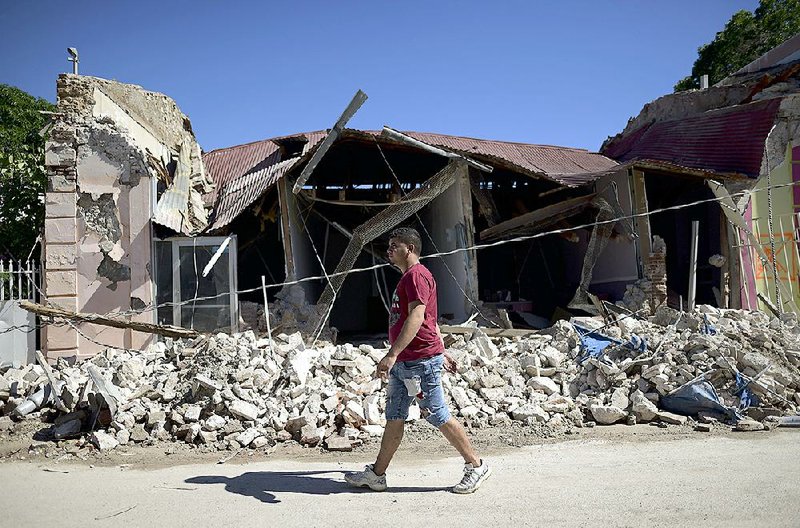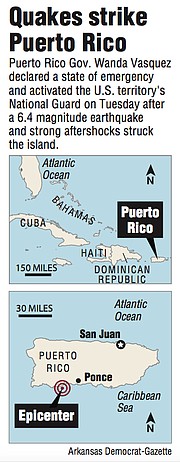GUAYANILLA, Puerto Rico -- Thousands of people fled their homes on Puerto Rico's southwest coast on Tuesday after a 10-day string of earthquakes crescendoed in a powerful magnitude-6.4 temblor that killed a man, injured at least eight other people and sent buildings tumbling to the ground.
Hours after the predawn quake cut power to the entire U.S. territory, a large area of southern Puerto Rico was shaken by smaller quakes late into Tuesday afternoon. Seismologists said there was no way of knowing when the series of quakes would ease, prompting Puerto Ricans to stay with friends or family members or even sleep outdoors far from the coast, fearful of collapsing buildings or a tsunami.
"I'm stringing up my hammock," said Miguel Santana, a 38-year-old resident of the southwest coastal town of Guayanilla.
Alexandra Colberg, 27, moved out of her deeply cracked home in the nearby town of Guanica with her husband and four children, packing their mattresses, a refrigerator, curtains and clothes into two pickups.
[Video not showing up above? Click here to watch » https://www.youtube.com/watch?v=84DBaB40e_E]
"What do I do with this?" asked her 9-year-old son, holding a tiny pink bucket with a pet fish that survived the earthquake.
"We need to go, because if not we could end up falling down there," Colberg said as she gestured to the ground floor from the second story of her home. She and her family soon left for the mountain town of Hormigueros, where Colberg's grandmother lives.
Most of the damage occurred in Guanica, where a three-story school collapsed.
The morning quake cut electricity to the island as power plants shut down to protect themselves. Authorities said two plants sustained light damage and they expected power to be restored later Tuesday. Puerto Rico's main airport was operating normally, using generator power.
Puerto Rico's governor, Wanda Vasquez, declared a state of emergency and activated the territory's National Guard. She said some 300,000 households remained without running water late Tuesday, and several hundred people were in shelters.
"We're talking about an event that Puerto Rico hasn't experienced in 102 years and we're talking about something that we can't predict," she said.
Tuesday's quake was the strongest to hit Puerto Rico since October 1918, when a magnitude-7.3 quake struck near the island's northwest coast, unleashing a tsunami and killing 116 people.
Puerto Rico is in an area prone to earthquakes, but Tuesday's quake was unusual because it struck just off the southern coast, said John Bellini, a geophysicist with the U.S. Geological Survey in Golden, Colo.
Most large quakes in the area happen some 60 to 80 miles off Puerto Rico's north coast, he said. Since 1950, there have now been five quakes of magnitude-6 or larger near Puerto Rico, and all the others have been far to the north, he said.
But since Dec. 31, more than 950 quakes and aftershocks have been recorded in the area of Tuesday night's shaking, most too weak to be felt, according to the Geological Survey.
The Caribbean islands are prone to quakes because they are at a spot where two tectonic plates meet in a complex dance. The North American plate is being driven below the Caribbean plate in some parts of the area, and the two plates are also rubbing each other sideways, Bellini said. As the plates move, they build up stress, eventually causing an earthquake.
The unusual location of Tuesday's quake means scientists don't have a detailed historical record to draw upon in trying to assess future activity, Bellini said. Residents can expect aftershocks for some weeks, but they will peter out in both size and frequency and eventually end, he said.
[Gallery not loading above? Click here for more photos » arkansasonline.com/18puertorico/]
The U.S. Geological Survey said that while it's virtually certain there will be many aftershocks in the next week, the chance of a magnitude-6 quake -- similar to Tuesday's -- or stronger is around 22%.
The risk of a magnitude-7 quake or bigger is extremely low, the agency said.
Teacher Rey Gonzalez said his uncle was killed when a wall collapsed on him at the home they shared in the city of Ponce. He said 73-year-old Nelson Martinez was disabled and that he and his father cared for him.
Eight people were injured in Ponce, officials said. Hundreds of people sat in the streets of the city, some cooking food on barbecue grills, afraid to return home for fear of structural damage and aftershocks.
President Donald Trump was briefed on the earthquakes in Puerto Rico in the past month, including the one on Tuesday, said Judd Deere, White House deputy press secretary.
"Administration officials, including FEMA Administrator Pete Gaynor, have been in touch with the governor and her team today, and we will continue to monitor the effects and coordinate with Puerto Rico officials," Deere said.
Information for this article was contributed by Malcolm Ritter and Michael Weissenstein of The Associated Press.
A Section on 01/08/2020

